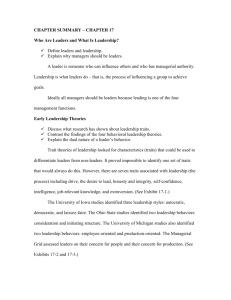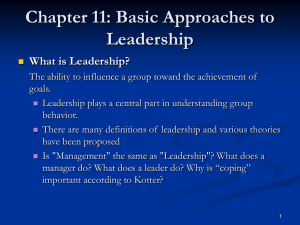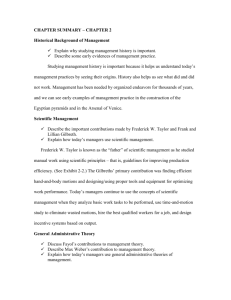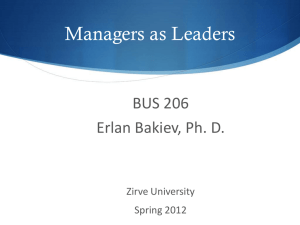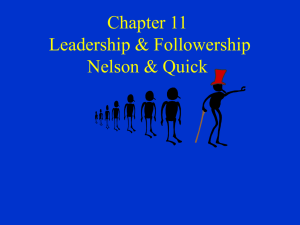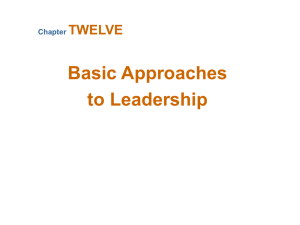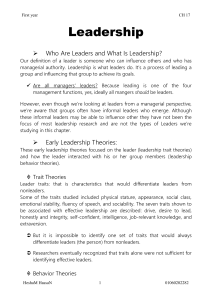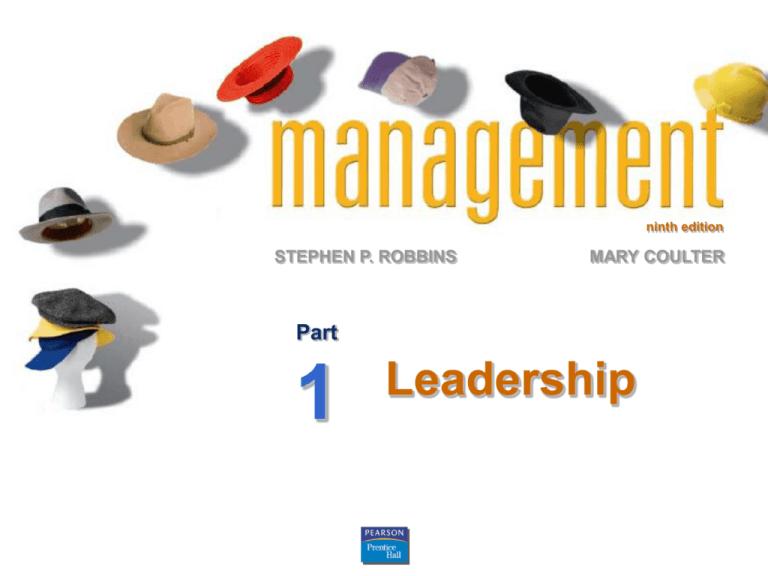
ninth edition
STEPHEN P. ROBBINS
MARY COULTER
Part
1
Leadership
Early Leadership Theories
• Trait Theories (1920s-30s)
Research focused on identifying personal
characteristics that differentiated leaders from
nonleaders was unsuccessful.
Later research on the leadership process identified
seven traits associated with successful leadership:
Drive,
the desire to lead, honesty and integrity, selfconfidence, intelligence, job-relevant knowledge,
and extraversion.
Exhibit 17–1
Seven Traits Associated with Leadership
Source: S. A. Kirkpatrick and E. A. Locke, “Leadership: Do Traits Really Matter?” Academy of Management
Executive, May 1991, pp. 48–60; T. A. Judge, J. E. Bono, R. llies, and M. W. Gerhardt, “Personality and
Leadership: A Qualitative and Quantitative Review,” Journal of Applied Psychology, August 2002, pp. 765–780.
Early Leadership Theories (cont’d)
• Behavioral Theories
Ohio State Studies
Identified
two dimensions of leader behavior
– Initiating structure: the role of the leader in defining his
or her role and the roles of group members
– Consideration: the leader’s mutual trust and respect for
group members’ ideas and feelings.
Research
findings: mixed results
– High-high leaders generally, but not always, achieved high
group task performance and satisfaction.
– Evidence indicated that situational factors appeared to
strongly influence leadership effectiveness.
Early Leadership Theories (cont’d)
• Behavioral Theories (cont’d)
University of Michigan Studies
Identified
two dimensions of leader behavior
– Employee oriented: emphasizing personal relationships
– Production oriented: emphasizing task accomplishment
Research
findings:
– Leaders who are employee oriented are strongly
associated with high group productivity and high job
satisfaction.
Exhibit 17–3
The
Managerial
Grid
Source: Reprinted by permission of Harvard Business Review. An exhibit from “Breakthrough in Organization Development” by Robert R. Blake, Jane S. Mouton,
Louis B. Barnes, and Larry E. Greiner, November–December 1964, p. 136. Copyright © 1964 by the President and Fellows of Harvard College. All rights reserved.
Contingency Theories of Leadership
• The Fiedler Model (cont’d)
Proposes that effective group performance depends
upon the proper match between the leader’s style of
interacting with followers and the degree to which the
situation allows the leader to control and influence.
Assumptions:
A certain
leadership style should be most effective
in different types of situations.
Leaders
do not readily change leadership styles.
– Matching the leader to the situation or changing the
situation to make it favorable to the leader is required.
Contingency Theories… (cont’d)
• The Fiedler Model (cont’d)
Least-preferred co-worker (LPC) questionnaire
Determines
leadership style by measuring
responses to 18 pairs of contrasting adjectives.
– High score: a relationship-oriented leadership
style
– Low score: a task-oriented leadership style
Situational factors in matching leader to the situation:
Leader-member
Task
structure
Position
power
relations
Contingency Theories… (cont’d)
• Leader Participation Model Contingencies:
Decision significance
Importance of commitment
Leader expertise
Likelihood of commitment
Group support
Group expertise
Team competence
Contingency Theories… (cont’d)
• Path-Goal Model
States that the leader’s job is to assist his or her
followers in attaining their goals and to provide
direction or support to ensure their goals are
compatible with organizational goals.
Leaders assume different leadership styles at
different times depending on the situation:
Directive
leader
Supportive
leader
Participative
leader
Achievement
oriented leader
Exhibit 17–7
Path-Goal Theory
Contemporary Views on Leadership
• Transactional Leadership
Leaders who guide or motivate their followers in the
direction of established goals by clarifying role and
task requirements.
• Transformational Leadership
Leaders who inspire followers to transcend their own
self-interests for the good of the organization by
clarifying role and task requirements.
Leaders who also are capable of having a profound
and extraordinary effect on their followers.
Contemporary Views…(cont’d)
• Charismatic Leadership
An enthusiastic, self-confident leader whose
personality and actions influence people to behave in
certain ways.
Characteristics of charismatic leaders:
Have
a vision.
Are
able to articulate the vision.
Are
willing to take risks to achieve the vision.
Are
sensitive to the environment and follower
needs.
Exhibit
behaviors that are out of the ordinary.
Contemporary Views…(cont’d)
• Visionary Leadership
A leader who creates and articulates a realistic,
credible, and attractive vision of the future that
improves upon the present situation.
• Visionary leaders have the ability to:
Explain the vision to others.
Express the vision not just verbally but through
behavior.
Extend or apply the vision to different leadership
contexts.
Dealing with Power
• Managing Power
Legitimate power
The power a leader has
as a result of his or her
position.
Coercive power
The power a leader has
to punish or control.
Reward power
The power to give
positive benefits or
rewards.
Expert power
The influence a leader
can exert as a result of
his or her expertise,
skills, or knowledge.
Referent power
The power of a leader
that arise because of a
person’s desirable
resources or admired
personal traits.
Leadership
• Universal Elements of
Effective Leadership
Vision
Foresight
Providing encouragement
Trustworthiness
Dynamism
Positiveness
Proactiveness
Gender Differences and Leadership
• Research Findings
Males and females use different styles:
Women
tend to adopt a more democratic or
participative style unless in a male-dominated job.
Women
Men
tend to use transformational leadership.
tend to use transactional leadership.
Exhibit 17–11 Where Female Managers Do Better: A Scorecard
Source: R. Sharpe, “As Leaders, Women Rule,” BusinessWeek, November 20. 2000, p. 75.

